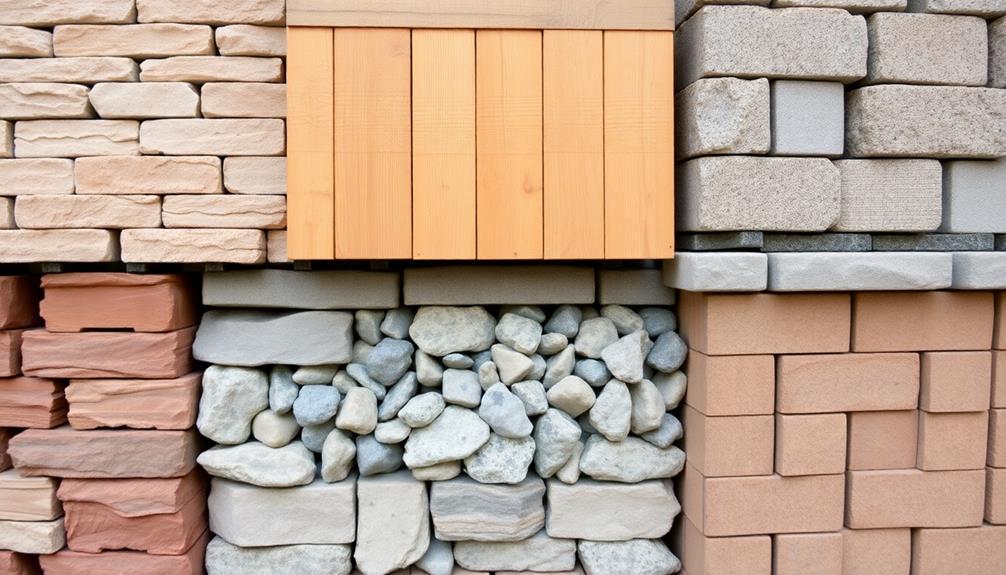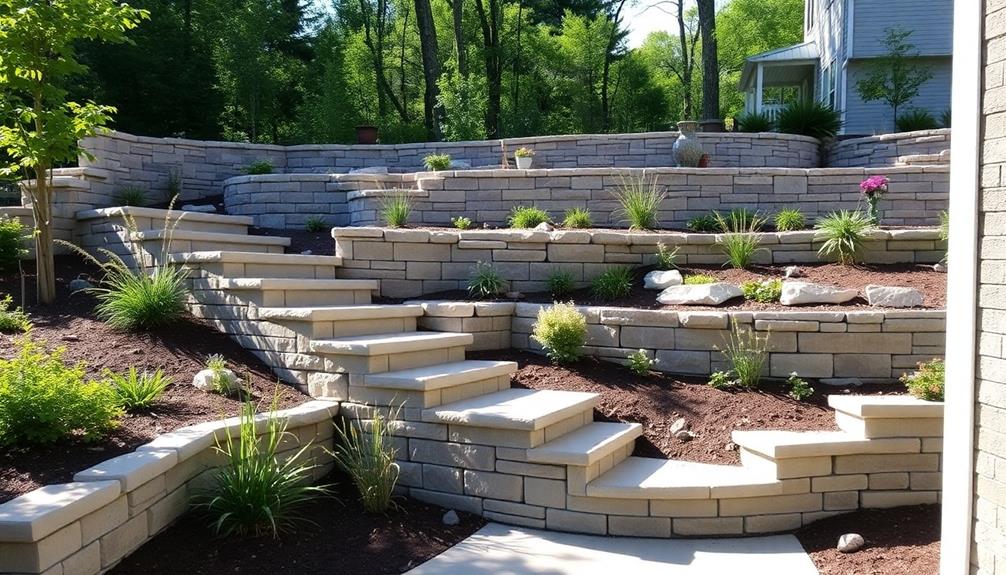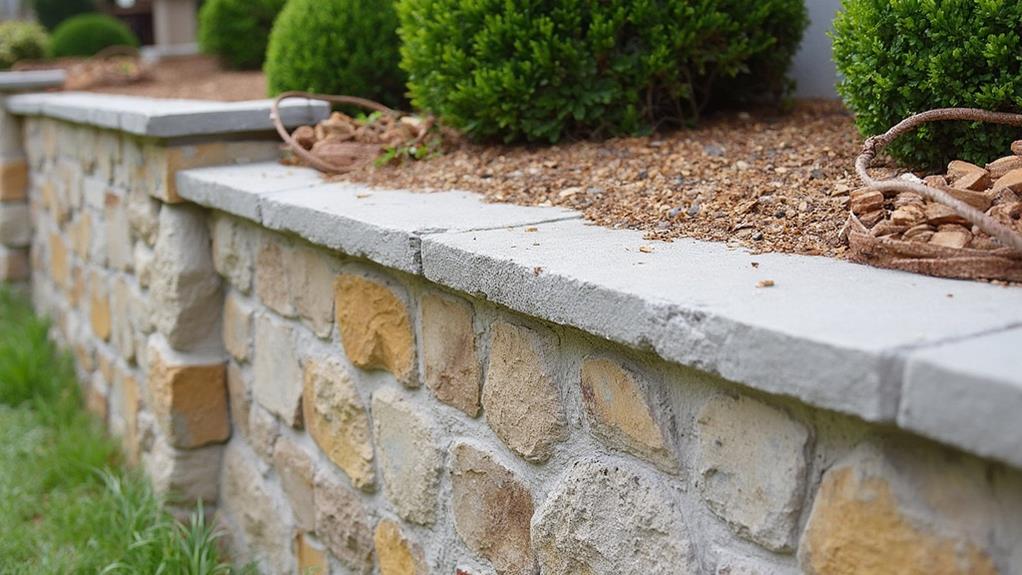Retaining wall materials present varied benefits, optimizing structural integrity and aesthetics for different landscape needs. Concrete blocks, known for their structural robustness and design flexibility, are favored in both residential and commercial projects. Natural stone offers a timeless aesthetic appeal, enhancing landscapes with its distinctive textures and colors, creating a sense of authenticity and craftsmanship. Timber, an economically favorable option, provides ease of installation along with a natural aesthetic suited to various environments. Each material presents unique strengths, such as durability, aesthetic harmony, and cost-effectiveness, guiding choices based on project demands and environmental impacts. Explore further to understand these aspects in depth.
Table of Contents
ToggleWalls Contractor Highlights
- Concrete blocks provide structural strength, design versatility, and ease of installation for various landscape projects.
- Natural stone offers unique textures, colors, and timeless aesthetic appeal for retaining walls.
- Timber is a cost-effective, easy-to-install option with natural aesthetics suitable for different landscapes.
- Advanced materials enhance retaining wall durability, ensuring safety and structural integrity over time.
- Environmental impact is reduced with recycled, locally sourced materials and permeable options for better water management.
Types of Retaining Wall Materials

In the selection of retaining wall materials, concrete blocks stand out for their versatility, offering a balance between strength and design flexibility, suitable for various landscaping applications.
Particularly, Boulder Walls, a company with over 20 years of expertise in constructing retaining walls, often utilizes a range of materials such as limestone, boulders, and granite, ensuring both aesthetic appeal and durability. Natural stone provides a unique aesthetic appeal, enhancing the visual elegance and character of any outdoor space through its timeless beauty and diverse textures.
Timber remains a cost-effective option that not only provides adequate structural support but also integrates seamlessly into natural settings, making it an attractive choice for those seeking both functionality and economy.
Concrete Block Versatility
Concrete blocks stand out as a popular choice in retaining wall construction due to their exceptional versatility. These blocks offer an unparalleled range of design options, structural integrity, and ease of installation, making them a fitting choice for both residential and commercial projects. By selecting concrete blocks, homeowners and builders alike can achieve a personalized aesthetic that complements various landscapes and architectural styles.
Concrete block retaining walls excel in several key areas:
- Design Flexibility: Concrete blocks come in diverse shapes, sizes, and colors. This allows for creative designs tailored to the unique terrain and personal preferences, helping foster a sense of belonging and cohesion within any community.
- Structural Strength: Their robust nature guarantees longevity and resilience, capable of withstanding the forces exerted by soil and environmental conditions. This strength offers peace of mind to those seeking durable solutions for their landscapes.
- Ease of Construction: With modular units that can be easily handled and assembled, concrete blocks simplify the construction process. This accessibility encourages participation and engagement among those involved in building projects, further reinforcing community ties.
Natural Stone Aesthetics
A timeless choice in retaining wall materials, natural stone offers unmatched aesthetic appeal and uniqueness to any landscape. This material not only imbues the surroundings with a sense of permanence and belonging but also amplifies the property's natural beauty.
Stone types such as granite, limestone, and sandstone offer a range of textures and colors, each with its own distinct character. The organic forms and inherent imperfections of natural stone suggest an authenticity that resonates with those who appreciate individuality and craftsmanship in their outdoor spaces.
The process of selecting natural stone for a retaining wall involves understanding the geological attributes of the stones, which affect durability and weather resistance. Granite, known for its hardness and longevity, withstands the test of time, while limestone brings a softer palette, ideal for rustic settings. Each piece of stone can be customized to fit specific design needs, making it a versatile choice for tailored projects.
The historical usage of stone in architecture and landscaping ties present-day installations to a rich heritage, providing continuity in design. This connection to the past fosters a sense of community and shared history, appealing to those who seek deeper roots in their living environment.
Timber Affordability
Timber serves as an economically viable option for constructing retaining walls, providing both versatility and ease of installation. This material appeals to homeowners and professionals alike, not just for its cost-effectiveness but also for its natural aesthetics, which can seamlessly integrate with various landscapes. The affordability of timber is not its sole allure; its combination of utility and availability makes it an attractive choice.
For those seeking community through shared interests in sustainable construction, timber offers a pathway to achieving both environmental and economic goals.
To elaborate on the aspects contributing to timber's affordability:
- Low Initial Investment: Compared to other materials like concrete or stone, timber requires a moderately lower initial financial outlay, making it accessible for projects with modest budgets.
- Ease of Procurement and Transport: Timber can be sourced locally in many regions, minimizing transportation costs and supporting community-based suppliers.
- Straightforward Installation: The simple handling and rapid installation process of timber reduce labor costs, which is particularly appealing in group building projects or collaborations.
In understanding these advantages, individuals keen on belonging to an environmentally conscious community may find timber an ideal alignment with their collective values and practical needs.
Benefits

Retaining wall materials present a range of benefits, including enhanced durability features that safeguard long-lasting structural integrity and diverse aesthetic appeal options that complement various landscape designs. For instance, boulder retaining walls provide a powerful and cost-effective solution for combating erosion and maintaining soil stability. These walls not only offer functional advantages but also boost curbside charm through their unique and creative designs.
Additionally, a thorough analysis of cost-effectiveness reveals that these materials offer significant value over time by reducing maintenance and replacement expenses. In addition, careful consideration of environmental impact factors highlights the potential for sustainable choices that minimize ecological footprint while meeting functional requirements.
Enhanced Durability Features
Incorporating advanced materials into retaining wall construction markedly enhances their durability, leading to substantial long-term benefits. By focusing on material innovations, we guarantee these structures not only meet but surpass performance expectations, providing peace of mind for communities and property owners alike. The use of reinforced concrete, for instance, not only bolsters structural integrity but also amplifies resistance to environmental stressors. Additionally, geosynthetic reinforcement offers another layer of stability, seamlessly integrating with the environment to mitigate soil movement.
The benefits of enhanced durability features can be distilled into three primary aspects:
- Longevity: Advanced materials extensively extend the lifespan of retaining walls, minimizing maintenance needs and replacement costs over decades.
- Stress Resistance: These materials are designed to withstand harsh weather conditions and soil pressure, safeguarding against structural failures and ensuring safety.
- Improved Performance: Incorporation of novel materials results in stronger, more adaptable structures that better accommodate complex terrains and topographical variations.
Such features not only reinforce the physical fortitude of retaining walls but also foster a sense of security and belonging within the community, knowing their infrastructure is built to last. As a result, adopting cutting-edge materials is a veritable investment in sustainable and reliable infrastructure development.
Aesthetic Appeal Options
Often enhancing the visual appeal of retaining walls is as significant as their structural functionality. Homeowners and landscape designers alike seek to create spaces that resonate not only with practical utility but also aesthetic harmony.
Retaining walls offer an array of aesthetic appeal options that can seamlessly integrate into diverse landscapes, transforming them into personalized expressions of beauty. These options include various textures, colors, and patterns that can be tailored to individual tastes, ensuring that each wall is a unique reflection of the surrounding environment.
Natural stone, for instance, provides a timeless, organic grace that complements both rustic and contemporary settings. On the other hand, modular concrete blocks can be designed for modernity, offering cleaner lines and a polished finish that speaks to formal garden styles. The use of veneers allows for the creative play of different surfaces and appearances, making it possible to mimic the look of more expensive materials without compromising durability.
These aesthetic choices extend beyond mere visual gratification; they contribute to a sense of place and identity, fostering a connection between the individual and their outdoor space. Retaining walls thus become more than barriers; they emerge as integral components of an immersive landscape experience.
Cost-Effectiveness Analysis
Evaluating the cost-effectiveness of retaining wall materials uncovers the financial and functional advantages they offer over time. This analysis assesses both initial investment and long-term value, essential for those seeking solutions that are not only durable but also economical. For homeowners and developers alike, choosing the right material can influence project viability and community harmony, as it reflects a shared commitment to quality and sustainability.
- Longevity: Materials such as concrete and natural stone, while potentially costlier at the outset, typically offer extended lifespans and require minimal maintenance, reducing future costs considerably.
- Structural Integrity: Engineered materials like geosynthetics enhance stability and withstand various environmental pressures, preserving functionality over decades, thereby maximizing cost-effectiveness.
- Adaptability: Some modern composite materials can be designed to fit diverse landscapes, preventing the need for extensive site preparation or modification, consequently saving on both time and expenses.
Environmental Impact Considerations
The environmental benefits of selecting the appropriate retaining wall materials extend beyond mere functionality and aesthetics. Opting for materials with a reduced ecological footprint can substantially mitigate the environmental impact, aligning construction practices more closely with sustainability goals. For instance, using recycled or locally sourced materials minimizes transportation emissions and lowers energy consumption. Such choices not only foster a sense of environmental stewardship among communities but also demonstrate a commitment to eco-friendly construction.
Incorporating permeable materials into retaining walls can significantly aid in water management. These materials facilitate groundwater recharge and reduce surface runoff, in this way decreasing the likelihood of erosion and flooding. Additionally, they contribute to the preservation of natural habitats by maintaining healthier water cycles and promoting biodiversity in surrounding areas.
Furthermore, the longevity and durability of sustainable retaining wall materials diminish the need for frequent repairs or replacements, reducing waste generation over time. As individuals and communities increasingly value eco-conscious living, selecting sustainable retaining wall materials becomes a display of shared ecological responsibility. These decisions collectively play a pivotal role in fostering a future where infrastructure and environmental harmony coexist, providing not just solutions to architectural challenges but also contributing positively to the planet's wellbeing.
Concrete Longevity and Durability

Concrete, a prevalent material for retaining walls, demonstrates exceptional longevity and durability, particularly due to its robust resistance to various environmental stressors, including frost, moisture, and chemical exposure. However, to maintain its structural integrity over time, periodic maintenance and timely repairs are essential to address minor issues before they escalate. The following table summarizes the key aspects of concrete's performance:
| Aspect | Description |
|---|---|
| Resistance | Withstands environmental challenges such as temperature fluctuations and moisture. |
| Maintenance | Requires regular inspections to identify and rectify potential problems. |
| Repairs | Early interventions can prevent the escalation of minor damages. |
| Durability | Offers a prolonged lifespan due to inherent strength and resilience. |
| Structural Integrity | Preserves its stability and load-bearing capacity, even as it ages. |
Resistance to Environmental Stressors
When considering materials for retaining walls, understanding their resistance to environmental stressors is indispensable, particularly regarding the longevity and durability of concrete. Concrete, by its very nature, possesses a high degree of resilience against many environmental challenges, including moisture, temperature fluctuations, and physical wear. This resilience roots in its composition, a mixture of cement, aggregates, and water that, once cured, forms a dense, cohesive structure.
However, achieving ideal durability requires a comprehensive understanding of factors affecting concrete performance over time.
- Moisture Resistance: Concrete's density allows it to withstand significant moisture, which is essential in preventing degradation such as freeze-thaw cycles that can lead to cracking and disintegration over repeated weather changes.
- Chemical Resistance: Concrete can be made more resistant to chemical attacks, such as those from salts and sulfates, through admixtures and sealants, prolonging its effective lifespan and preventing possible weakening.
- Load-Bearing Capacity: Its structural integrity under load is another factor in its endurance, allowing it to maintain functionality and appearance against erosion and mechanical damage.
These attributes make concrete a popular choice for those who value stability and strength, fostering a sense of security and belonging in our built environments.
Maintenance and Repair Needs
Addressing the durability of concrete in retaining walls involves not just selecting the right material but also recognizing the maintenance and repair needs that impact its lifespan. Concrete is prized for its strength and resilience, but without adequate attention to its upkeep, its longevity might be compromised.
Concrete retaining walls require routine inspections to identify signs of cracking or spalling, particularly in regions with extreme weather changes. These small-scale damages, if left unchecked, can exacerbate over time, leading to structural weakness and potential failure.
Frequent exposure to water can also threaten a wall's integrity, necessitating the application of sealants or moisture barriers to prevent water ingress and freeze-thaw cycles that aggravate deterioration. Moreover, maintenance should include checking for efflorescence—a white, powdery deposit from water infiltration—which, while mostly cosmetic, indicates underlying moisture issues that warrant prompt consideration.
Regular cleaning to remove surface stains and organic growths can preserve the concrete's aesthetic while guaranteeing it remains robust against the elements.
Repair strategies might involve patching minor cracks with appropriate concrete repair products or, for more significant concerns, professional intervention to restore the wall to its ideal condition. Proper maintenance practices guarantee a balance between the concrete's initial durability and its ongoing reliability.
Structural Integrity Over Time
Over time, evaluating the structural integrity of concrete retaining walls becomes essential to guarantee their longevity and durability are not compromised. The passage of decades subjects these structures to a variety of environmental and physical stressors that can challenge even the most robust designs.
Examining their condition involves understanding the specific factors that contribute to their ongoing resilience. Consider these key elements:
- Environmental Stressors: Concrete walls can be affected by freeze-thaw cycles, moisture ingress, and chemical exposure, which may lead to erosion and surface degradation. Regular inspection helps in identifying early signs of these stresses.
- Material Quality: The initial selection of high-quality concrete and the use of appropriate reinforcement profoundly influence the wall's ability to withstand time. Continuous advancements in concrete technology, incorporating innovative additives and mixed designs, can provide enhanced performance.
- Maintenance Practices: Routine maintenance is imperative. This includes cleaning drainage systems to prevent water accumulation and identifying needed repairs early. Well-maintained walls are less likely to suffer long-term damage.
Walls Contractor FAQ
How Do I Choose the Right Retaining Wall Material for My Landscape Design?
Selecting the ideal retaining wall material for your landscape design involves evaluating factors such as aesthetics, durability, cost, and environmental impact. Consider community preferences and seek professional advice to guarantee a harmonious and effective design solution.
Are There Any Environmentally Friendly Options for Retaining Wall Materials?
Eco-friendly retaining wall materials include recycled concrete, sustainably-sourced wood, and natural stone. Utilizing these materials not only supports environmental stewardship but also enhances a sense of community commitment to sustainable practices and harmonious landscape integration.
What Is the Average Cost of Installing a Retaining Wall?
The average cost of installing a retaining wall ranges from $20 to $50 per square foot, dependent on materials, design, and location. Choosing sustainable materials can enhance value, fostering community appreciation for environmentally conscious development.
How Do Retaining Wall Materials Affect Drainage Efficiency?
Retaining wall materials greatly influence drainage efficiency. Porous materials like concrete blocks amplify water seepage, reducing pressure build-up. Conversely, impermeable options like treated wood may require additional drainage solutions to safeguard structural integrity and maximal function within the community's infrastructure.
Do Retaining Walls Require Any Special Maintenance or Upkeep?
Retaining walls necessitate regular inspections to identify cracks, erosion, or drainage issues. Ensuring proper drainage, addressing wear, and cleaning to prevent vegetation overgrowth are critical tasks, fostering an environment where these structures perform effectively and blend seamlessly with their surroundings.







